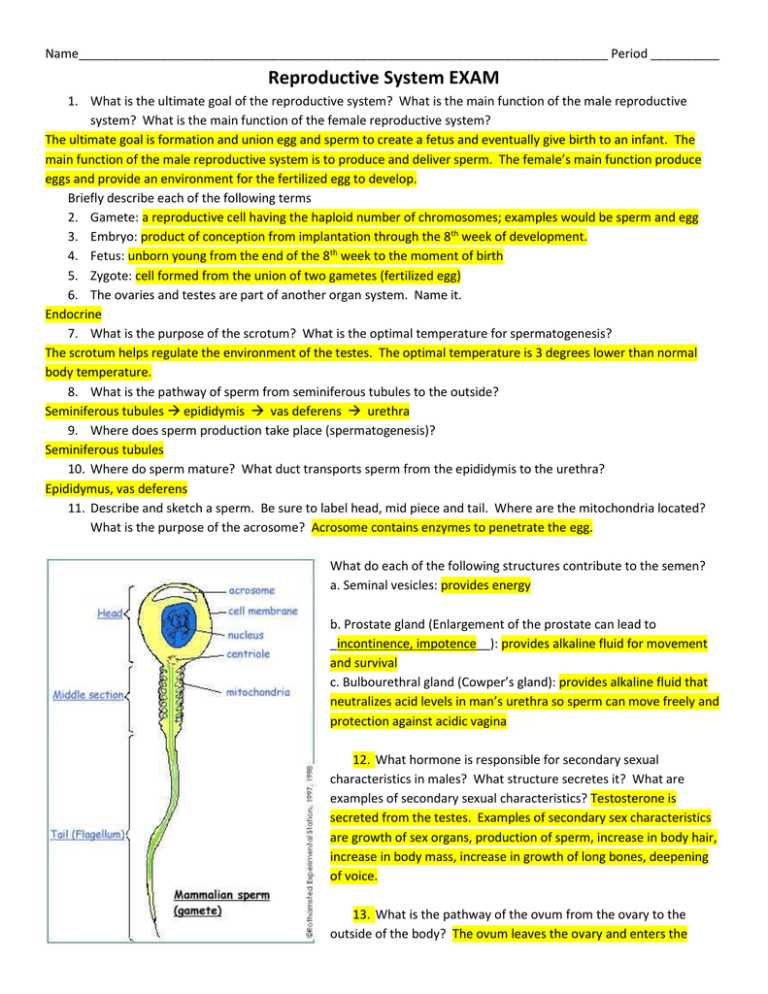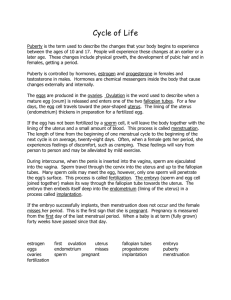Reproductive System EXAM
advertisement

Name_____________________________________________________________________________ Period __________ Reproductive System EXAM 1. What is the ultimate goal of the reproductive system? What is the main function of the male reproductive system? What is the main function of the female reproductive system? The ultimate goal is formation and union egg and sperm to create a fetus and eventually give birth to an infant. The main function of the male reproductive system is to produce and deliver sperm. The female’s main function produce eggs and provide an environment for the fertilized egg to develop. Briefly describe each of the following terms 2. Gamete: a reproductive cell having the haploid number of chromosomes; examples would be sperm and egg 3. Embryo: product of conception from implantation through the 8th week of development. 4. Fetus: unborn young from the end of the 8th week to the moment of birth 5. Zygote: cell formed from the union of two gametes (fertilized egg) 6. The ovaries and testes are part of another organ system. Name it. Endocrine 7. What is the purpose of the scrotum? What is the optimal temperature for spermatogenesis? The scrotum helps regulate the environment of the testes. The optimal temperature is 3 degrees lower than normal body temperature. 8. What is the pathway of sperm from seminiferous tubules to the outside? Seminiferous tubules epididymis vas deferens urethra 9. Where does sperm production take place (spermatogenesis)? Seminiferous tubules 10. Where do sperm mature? What duct transports sperm from the epididymis to the urethra? Epididymus, vas deferens 11. Describe and sketch a sperm. Be sure to label head, mid piece and tail. Where are the mitochondria located? What is the purpose of the acrosome? Acrosome contains enzymes to penetrate the egg. What do each of the following structures contribute to the semen? a. Seminal vesicles: provides energy b. Prostate gland (Enlargement of the prostate can lead to _incontinence, impotence__): provides alkaline fluid for movement and survival c. Bulbourethral gland (Cowper’s gland): provides alkaline fluid that neutralizes acid levels in man’s urethra so sperm can move freely and protection against acidic vagina 12. What hormone is responsible for secondary sexual characteristics in males? What structure secretes it? What are examples of secondary sexual characteristics? Testosterone is secreted from the testes. Examples of secondary sex characteristics are growth of sex organs, production of sperm, increase in body hair, increase in body mass, increase in growth of long bones, deepening of voice. 13. What is the pathway of the ovum from the ovary to the outside of the body? The ovum leaves the ovary and enters the fallopian tubes and then the uterus past the cervix and into the vagina to the outside of the body. Name the reproductive structure being described. 14. Tubes that transports eggs __fallopian tubes_________________________ 15. Copulation takes place here __vagina_______________________________________ 16. Expands to 500 times its normal size ___uterus______________________________________ 17. Fertilization takes place here __fallopian tubes_______________________________ 18. Neck of the uterus __cervix_______________________________________ 19. Connects ovaries to uterus __fallopian tubes________________________________ 20. Passageway from uterus to outside ___vagina______________________________________ 21. Finger-like structure around the internal opening of the fallopian tube ___fimbrae______________________ 22. Contains environment to allow for development of fertilized egg __uterus____________________________________ 23. What hormone is responsible for secondary sexual characteristics in females? What structure secretes it? What are examples of secondary sexual characteristics? Estrogen end secreted from the ovaries. Examples of secondary sex characteristics are growth of sex organs, increase in body hair, increase in growth of long bones, broadening of hips, fat deposits and menstrual cycle. 24. The length of a normal menstrual cycle is ___28 days____________. 25. Progesterone causes changes in the lining of the _uterus______________. (endometrium) 26. If the egg is not fertilized, the uterus lining (endometrium) is __shed________. 27. What is another name for oviduct? __fallopian tube____________ 28. What is ovulation? How often does it happen? _An egg ruptures from the ovary and passes into the fallopian tube about every 28 days.____________________ 29. Another name for the oviduct is ____fallopian tube________. 30. What is fertilization? Union of egg and sperm 31. Name the 3 bacterial infections. Chlamydia, syphilis, gonorrhea 32. Name 4 viral infections. Hepatitis B, Genital Herpes, Genital warts, HIV (AIDS) 33. Name 5 risk factors for contracting an STD. Person who has multiple sex partners Unprotected sex (even once) History of STD or has a current STD Drug user Sex partner of drug user Person who has sex for drugs/money Sex partner of person who has sex for drugs/money Between the ages of 12-26 Sexual practices/ Exposure sites Briefly describe the major symptoms of the following diseases 34. Gonorrhea: Milky discharge from penis/vagina, rectum; burning/itching on urination 35. Chlamydia: can be asymptomatic; men and women can experience abnormal discharge and burning on urination 36. Syphilis/ (What major organs are affected by untreated (3rd stage) syphilis? Stage 1: chancre Stage 2: if not treated, the bacteria enters the bloodstream and causes flu like symptoms and rash. Stage 3: bacteria has damaged major organs like heart, spinal cord and brain 37. Genital Herpes: itching burning sensation in genital area; blisters or painful open sores 38. Genital Warts: caused by HPV (Human Papilloma Virus); warts in genital areas 39. HIV/AIDS (What do they stand for) no symptoms initially; HIV (Human Immunodeficiency Virus) and AIDS (Acquired Immune Deficiency Syndrome); the virus attacks the immunes system specifically Thelper cells.








